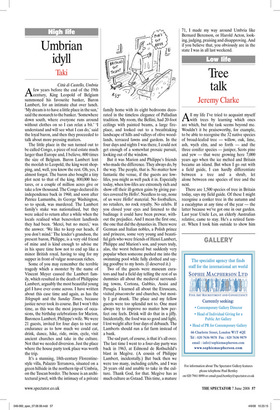Tree talk
Jeremy Clarke
All my life I’ve tried to acquaint myself with trees by learning which ones are which, but the task seems beyond me. Wouldn’t it be praiseworthy, for example, to be able to recognise the 32 native species of broad-leafed tree — willow, oak, lime, ash, wych elm, and so forth — and the three conifer species — juniper, Scots pine and yew — that were growing here 7,000 years ago when the ice melted and Britain became an island. But when I go out with a field guide, I can hardly differentiate between a tree and a shrub, let alone between one species of tree and the next.
There are 1,500 species of tree in Britain today, says my field guide. Of these I might recognise a conker tree in the autumn and a eucalyptus at any time of the year — the latter because we’ve got one in our garden. Last year Uncle Les, an elderly Australian relative, came to stay. He’s a retired farmer. When I took him outside to show him round the garden, he said, ‘You’ve got a gum tree!’ ‘Isn’t it lovely,’ I said.
He spat. ‘Dirty tree,’ he said, reproving it as though it were a dog or a child. And the old settler was right. It looks graceful, but the mess it makes by shedding bark, leaves and small branches has to be seen to be believed.
Les asked lots of questions about our trees and was flabbergasted at how little we knew. ‘That’s a pretty tree,’ he’d say. ‘What d’you call that?’ We’d all stand there scratching our heads. ‘You don’t know much about your own bloody country, do you?’ he’d say. Right again. Here in our coastal retirement village, most of us know more about knife crime in south London than we do about trees.
When Les returned down under, I was shamed enough to book a place on a guided Sunday afternoon walk led by a local tree expert. The walk was entitled ‘Trees for health’; its purpose to teach us how to identify different species, and which parts of them are worth harvesting for food and medicine.
We gathered in a small car park down by the river. The leader, called Iris, wrote down our names and email addresses as we arrived and took our money. Then she asked us to introduce ourselves to the group and to explain in a few words why we’d come along. ‘I like how big and strong and amazing trees are, and I want to learn more about them and I’d like to ask for their forgiveness,’ said a woman, I’d guess in her sixties, called Ruth.
‘I adore trees. I’m a late starter with things spiritual but I have a hunger,’ said middleaged Tom.
Shimako, a young Japanese woman, said that she loved trees because of all living beings it seemed to her that trees were the most resigned to the way they live.
In Frazer’s seminal study of magic and religion The Golden Bough, the eminent Victorian says this:
To the savage the world in general is animate, and trees and plants are no exception to the rule. He thinks that they have souls like his own, and he treats them accordingly.
It’s strange to think that fewer than 100 years ago animism was seen as a classic symptom of a primitive mind and today it is the height of European middle-class sophistication. Of the eight of us, six made statements that one way or another conformed to the animist view that trees had souls. The two exceptions were myself — I said I wanted to learn how to identify a few native species — and a horrid little boy called Esben, who said he hated trees just to upset his doting parents.
Introductions over, Iris led us along the towpath until we came to our first tree. We gathered around. One of the animists began stroking the leaves and making cooing noises. ‘Can anyone tell me what this tree is?’ said Iris. We couldn’t. But then neither could Iris at first. ‘Actually,’ she said, ‘I’m not sure what this is myself.’ She stretched her neck out this way and that looking for clues. It was a smallish tree, 20-feet high at most, with a trunk no thicker than a flag pole.
And then somebody pointed to a lone, insect-ravaged apple still clinging to one of the upper branches and wondered whether this meant we were looking at an apple tree. ‘Of course. Of course,’ said Iris, somewhat rattled. ‘Sorry, folks. I couldn’t get my head around that one for a second. It just shows you, tree identification is not always a simple matter, even for the tree specialist.’ I took a lot of comfort from Iris saying that.











































































 Previous page
Previous page